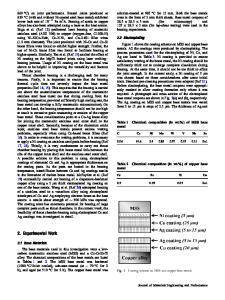Brazing of hot isostatically pressed-Al 2 O 3 to stainless steel (AlSl 304L) by Mo-Mn route using 72Ag-28Cu braze
- PDF / 473,180 Bytes
- 8 Pages / 612 x 792 pts (letter) Page_size
- 0 Downloads / 266 Views
I. INTRODUCTION
JOINING of the ceramic component to metals/alloys finds wide applications in electrical, structural, and ultrahigh-vacuum technologies. The advantages of ceramic materials, such as good strength, high operating temperatures, low thermal and electrical conductivity, considerable wear resistance, small linear coefficient of expansion, and chemical stability in corrosive as well as in oxidizing environments under different thermal conditions can in many cases be combined with the better known properties of metals. Such a combination of complimentary properties of metal and ceramic promises faster technological growth that is otherwise impossible with metals and ceramics alone. Joining metals with ceramics is a difficult task largely because of the thermal coefficient of expansion mismatch. Various techniques have been developed over the last 3 decades to join the important oxide ceramics such as alumina with metals/ alloys. However, in practice, any particular technique that can be employed for a specific product application is often severely limited by economic considerations as well as service conditions. The different techniques available for joining alumina (Al2O3) to stainless steel include powder-phase sintering and brazing,[1] liquid-phase sintering,[2] solid-state bonding,[3] and active metal brazing.[4,5,6] The present article focuses on joining of hot isostatically pressed alumina (HIPAl2O3) to stainless steel (AISI 304L) by Mo-Mn (molymanganese) route using 78Ag-28Cu alloy—a process that falls in the powder-phase sintering and brazing category. P. MISHRA, S.N. ATHAVALE, A.L. PAPPACHAN, and A.K. GROVER, Scientific Officers, Materials Processing Division, A.K. SURI, Head, Materials Processing Division, P. SENGUPTA, G.B. KALE, and K. BHANUMURTHY, Scientific Officers, Materials Science Division, and P.K. DE, Head, Materials Science Division, are with the Bhabha Atomic Research Centre, Mumbai 400 085, India. Contact e-mail: aditya@magnum. barc.ernet.in Manuscript submitted November 23, 2004. METALLURGICAL AND MATERIALS TRANSACTIONS A
In general, joining of Al2O3 to metals/alloys by ‘Mo-Mn process’ involves two important stages: (1) metallization of ceramic material and (2) joining the metallized ceramic to metals/alloy using a suitable brazing alloy. Extensive work has been reported on joining of Al2O3 to stainless steel via the Mo-Mn route,[7,8,9] and the technological development resulted in publication of several patents.[10–13] Much of this published literature is related to joining of debased Al2O3 to stainless steel,[7] and very limited work has been reported on joining HIP-Al2O3 to stainless steel.[6] Moreover, the microstructural evolution at various stages of brazing is not well studied. The present article discusses the methodology for joining HIP-Al2O3 to stainless steel (AISI 304L) by the Mo-Mn process and describes detailed microstructural evolutions of the metal/ceramic joints at various stages of the joining process. II. EXPERIMENTAL WORK A. Materials Selection, metallization, and
Data Loading...











